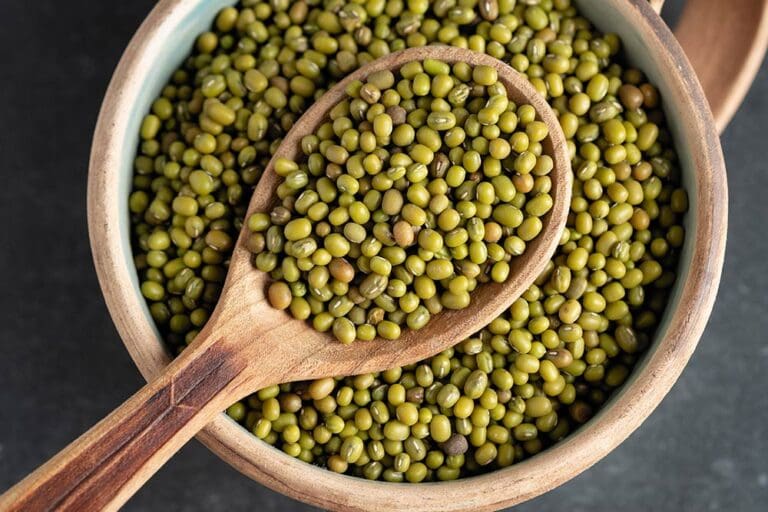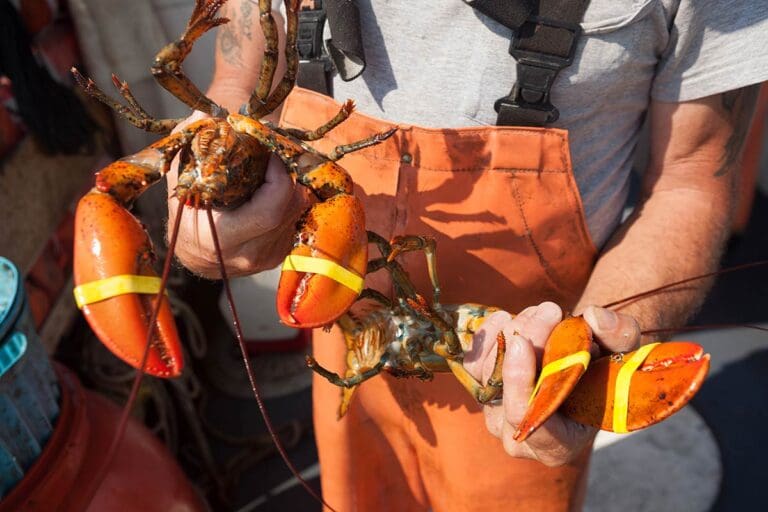Major Hurricane Beryl recently made headlines as the earliest Category 5 storm on record, causing severe destruction to Caribbean islands in its path. This significant development marks an intense start to an Atlantic hurricane season, expected to be above-average in strength and activity, driven by a combination of storm-conducive conditions. Industries and agriculture in the hurricane zone should closely monitor the situation to increase preparedness and mitigate market disruptions.
Key factors influencing the 2024 hurricane season
Record Atlantic Ocean Temperatures
A major factor in hurricane strength is sea surface temperature. Warm ocean temperatures, combined with moist and warm air, can cause storms to undergo rapid intensification, increasing wind speeds. This intensification not only leads to more severe destruction of commodities and livelihoods but also complicates the prediction of a storm’s trajectory and characteristics.
Since June 2023, Atlantic Ocean surface temperatures have been at record levels (Fig.1). This trend is expected to fuel a highly active and strong 2024 hurricane season, which spans from June to November. The peak months for hurricanes are generally August and September, therefore, preparation during this period is vital for industries in the Caribbean and along the Gulf Coast in Mexico and the US.
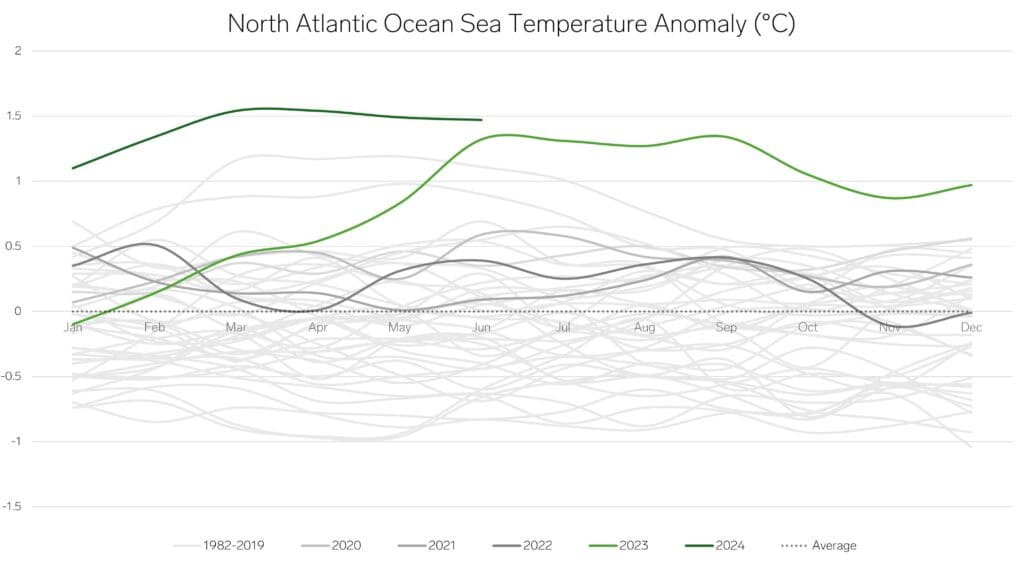

African Easterly Waves (AEWs)
African Easterly Waves (AEWs) are responsible for 80% of tropical storms developed in the Atlantic basin. These disturbances, influenced by temperature, humidity, and wind speeds, are most frequent between August and September. The European Centre for Medium-Range Weather Forecasts (ECMWF) predicts a warm and wet West African summer, indicating favorable conditions for AEW formation and, consequently, more tropical storms in the Atlantic basin.
La Niña events
There is also a link between La Niña events and increased hurricane activity in the Atlantic Ocean. Global El Niño – Southern Oscillation (ENSO) forecast models have varied outlooks, suggesting a range from ENSO Neutral to a Moderate La Niña event for the season (Fig. 2). Expana’s average of these models indicates a Weak La Niña event for 2024. This scenario could enhance hurricane activity in the Atlantic by reducing vertical wind shear in the development region while suppressing it in the eastern Pacific.
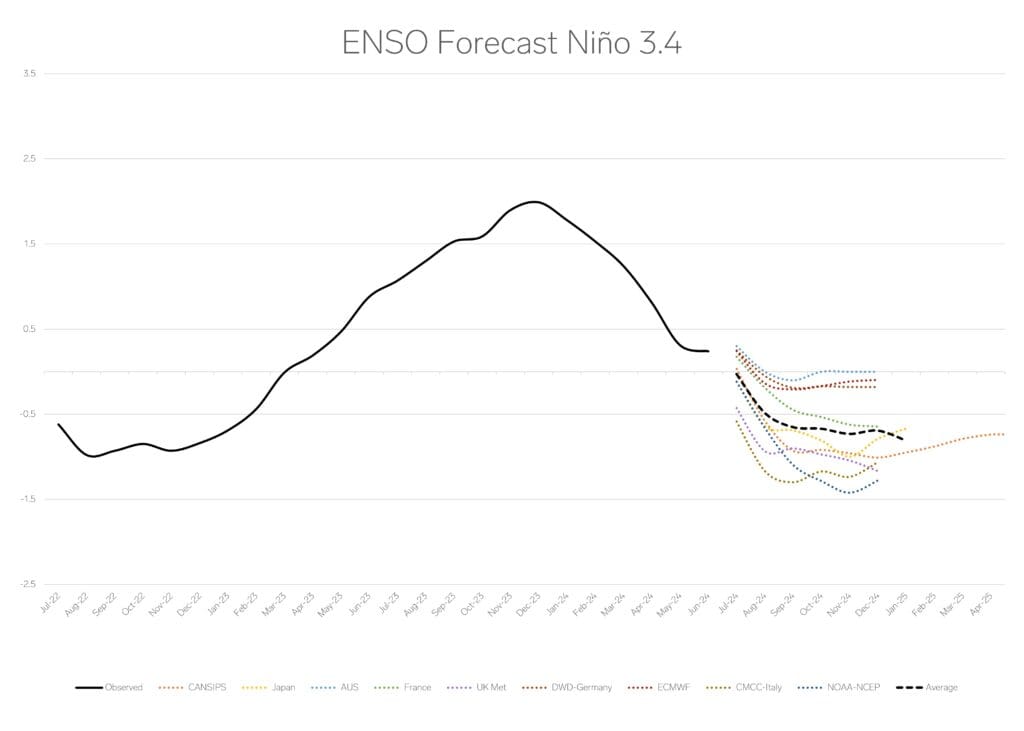

Impact of Hurricane Beryl
Caribbean devastation
Hurricane Beryl, the first hurricane of the season, was a Category 4 storm when it struck Grenada, Barbados, and St. Vincent and the Grenadines on 1st July, with wind speeds reaching 150 mph. Before Beryl, all the affected islands were on target to reach CARICOM’s goal of reducing food import costs by 25%. The storm has caused a major setback to this, wiping out 50% of plantain and banana crops, as well as root vegetables across the islands, crucial for their economies and food security.
Beryl intensified to a Category 5 Major Hurricane before reducing to a Category 4 storm upon reaching Jamaica. The Jamaican government reported US$64 million in agricultural damage, particularly to fruit trees and greenhouses. Additionally, 10% of fishing boats and a significant share of poultry were damaged or lost, along with essential infrastructure.
Landfall in Mexico and Texas
Hurricane Beryl made landfall on the Yucatan Peninsula in Mexico as a Category 2 storm, but its weakening state meant less aggressive impact. Consequently, Mexican oil platforms and agriculture were not significantly affected.
Beryl re-intensified slightly before making landfall again in Texas on 8th July as a Category 1 storm. Texas, a major hub for cattle, cotton, and grain farming, experienced some crop damage, particularly to sorghum, corn, and cotton. However, the damage was not extensive, and other states’ production should compensate for any deficits from Texas. Despite long-term drought, the rain brought by Beryl was not enough to significantly replenish reserves.
Although Hurricane Beryl’s disruption in the US was minor, future strong storms this season remain a threat to both agricultural production and supply chains. Texas houses a substantial proportion of US feed mills and feed additive production facilities, such as methionine. Impacts to these facilities or ports in the region can influence feed distribution across the US.
Supply chain resilience
Preparation is key to mitigating the impacts of such powerful storms. Industries, ports, and agricultural sectors are advised to implement robust disaster management plans. This includes securing infrastructure, diversifying supply chains, and investing in advanced forecasting technologies.
Power outages are common when hurricanes make landfall, which can delay production at facilities, warehouses and ports, leading to transportation delays and increased costs. Logistics may also need rerouting during periods of high wind speeds or storm-related flooding, also delaying trade and increasing costs. Further down the chain, disruptions can lead to supply shortages, impacting retailers and in severe cases, can change consumer buying habits.
For example, in 2005, Hurricane Katrina damaged oil refineries and New Orleans ports, which led to significant disruption to the energy supply chain and an increase in fuel prices.
Future risks
Figure 3 illustrates the areas of North America most at risk of hurricane landfall. The most frequently hit over the past 20 years was Florida, which has also experienced one Category 5 and three Category 4 landfalls. Hurricanes impacting Florida puts important crops at risk, including sugar cane, peppers, peanuts (groundnuts), watermelons, cucumbers, and grapefruit. Similarly, states further west, such as Texas, also experience frequent and intense hurricanes. This region is a major supplier of various crops, meats, and energy. A list of key commodities produced within the U.S. hurricane zone is provided in Table 1, highlighting the significance of the region as a national production zone.



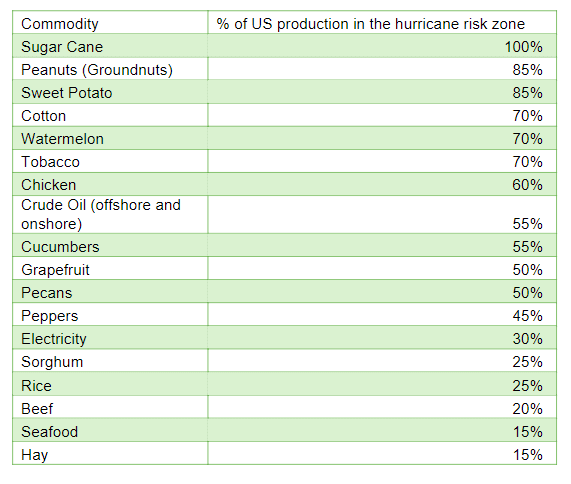
Hurricanes can also impact ocean life. Strong currents and rapid changes in ocean temperatures and salinity can decimate slow-moving fish and shellfish beds. However, other sea creatures that can migrate away from unfavorable waters often return once conditions stabilize, experiencing only temporary impacts.
Hurricane Beryl has provided an early insight into this year’s potentially destructive Atlantic hurricane season, serving as a warning for industries, ports, and agriculture along the US and Mexico Gulf Coast and throughout the Caribbean. The combination of warm ocean temperatures, favorable conditions for AEW development, and the potential influence of a La Niña event suggests that the 2024 Atlantic hurricane season is one to closely monitor.
Meanwhile, the 2024 Typhoon season in the west Pacific Ocean runs from May to October and is predicted to be below to near-normal, after three consecutive years of below-normal activity. This is beneficial to industries and ports along the coast of China, Japan and Southeast Asia.
Want to dig into further insights? Discover more on our total insights page.

